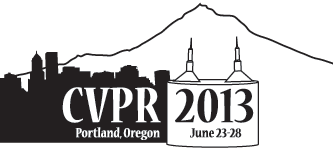-
Top-Down Segmentation of Non-rigid Visual Objects Using Derivative-Based Search on Sparse Manifolds
AbstractThe solution for the top-down segmentation of non-rigid visual objects using machine learning techniques is generally regarded as too complex to be solved in its full generality given the large dimensionality of the search space of the explicit representation of the segmentation contour. In order to reduce this complexity, the problem is usually divided into two stages: rigid detection and non-rigid segmentation. The rationale is based on the fact that the rigid detection can be run in a lower dimensionality space (i.e., less complex and faster) than the original contour space, and its result is then used to constrain the non-rigid segmentation. In this paper, we propose the use of sparse manifolds to reduce the dimensionality of the rigid detection search space of current stateof-the-art top-down segmentation methodologies. The main goals targeted by this smaller dimensionality search space are the decrease of the search running time complexity and the reduction of the training complexity of the rigid detector. These goals are attainable given that both the search and training complexities are function of the dimensionality of the rigid search space. We test our approach in the segmentation of the left ventricle from ultrasound images and lips from frontal face images. Compared to the performance of state-of-the-art non-rigid segmentation system, our experiments show that the use of sparse manifolds for the rigid detection leads to the two goals mentioned above.
Related Material
[pdf][bibtex]@InProceedings{Nascimento_2013_CVPR,
author = {Nascimento, Jacinto C. and Carneiro, Gustavo},
title = {Top-Down Segmentation of Non-rigid Visual Objects Using Derivative-Based Search on Sparse Manifolds},
booktitle = {Proceedings of the IEEE Conference on Computer Vision and Pattern Recognition (CVPR)},
month = {June},
year = {2013}
}
These CVPR 2013 papers are the Open Access versions, provided by the Computer Vision Foundation.
Except for the watermark, they are identical to the accepted versions; the final published version of the proceedings is available on IEEE Xplore.
Except for the watermark, they are identical to the accepted versions; the final published version of the proceedings is available on IEEE Xplore.
This material is presented to ensure timely dissemination of scholarly and technical work.
Copyright and all rights therein are retained by authors or by other copyright holders.
All persons copying this information are expected to adhere to the terms and constraints invoked by each author's copyright.

